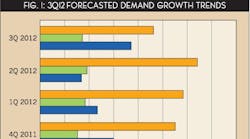To gauge near-term trends for 3Q 2012, we have again conducted our proprietary KeyBanc Capital Markets Electrical Distributor survey in association with Electrical Wholesaling magazine. This is our ninth quarterly survey of North American electrical distributors in partnership with the magazine. We received several dozen responses detailing trends in sequential demand, pricing, inventories and outlook going forward. Following are the key takeaways from this survey.
In 3Q 2012, sequential demand trends came in weaker than the historic seasonal pattern. Exemplifying the lower sequential rate of growth, a lower mix of respondents in 3Q 2012 (46%) realized some sequential growth as compared to the 3Q 2011 (66%), which validates the weaker than historically seasonal pattern (Fig. 1).
Based on the conditions cited in the survey, we estimate end demand rose 0.2% sequentially in 3Q 2012. The overall sequential performance is considerably lower than the historical average of up 4.1% noted by participants and is a significant deceleration from the year-ago period (Fig. 2). It's likely the lower than average demand trends in the 3Q 2012 are a direct result of a better-than-expected 1Q 2012, which could have benefitted from an unusually warm winter. While one quarter doesn't signify a trend, it appears the generally weak recent domestic macroeconomic indicators continue to indicate a sluggish at best demand environment.
Inventories reduction was underway
Survey respondents said inventory levels had begun to diminish, and it appears distributors are seeking to reduce or maintain their levels of inventory as growth stagnates. Most respondents said heading into the 4Q 2012 they will be maintaining their current levels (Fig. 3), with only a slightly larger percentage of respondents increasing inventories when compared to 2011 (26% in 4Q12 versus 23% in 4Q11). We think this points to a measure of caution from distributors who seem less willing to expand inventory levels for the December quarter given the sluggish demand trends and an uncertain political environment at the time of the survey.
The construction market sees the largest price concessions
The strongest pricing concessions for distributors came in the residential/non-residential construction markets, which is likely due in part to recent weakness in the U.S. construction market, but this uptick does not seem to be reflective of the sustained price competition in the non-residential construction market. In addition, it appears this stagnant trend yields the competitive pricing environment, as residential construction does not seem to enjoy much pricing latitude. Despite this, results from our survey indicated products sold into the voice-data-video and national accounts end markets were able to realize the least amount of pricing concessions during the quarter.
Hiring declined from 1Q 2012 and 2Q 2012, but the outlook for the balance of 2012 is incrementally optimistic
It appears the employment situation in 3Q 2012 slipped compared to the previous quarter, with a lower amount of respondents (79% versus 91% in 2Q 2012) noting that they have largely retained existing levels of employment, added hours to existing employee workload or hired new employees due to high capacity. These results are below 1Q 2012 (86.7% of respondents).
Looking at distributors' customers, they find that the employment situation has slightly declined on a sequential basis, as approximately 61% retained employees, added employee hours or hired new associates. While this is down from 66% in 2Q 2012 and 67% in 1Q 2012, the percentage of new hires showed more improvement on a sequential basis (11% versus 2% in 2Q 2012). It's interesting that distributors' customers have an incrementally optimistic view of the second half of 2012 with more customers seeming to be optimistic or cautiously optimistic (60% versus 47% in 2Q 2012).
The authors are analysts for KeyBanc Capital Markets Inc. in Cleveland and can be reached at either [email protected] or [email protected].












